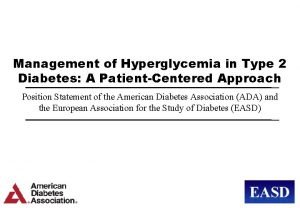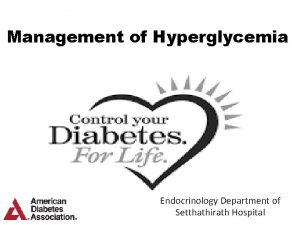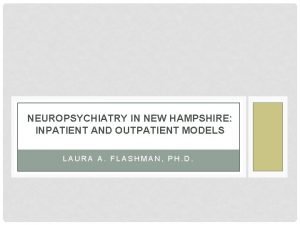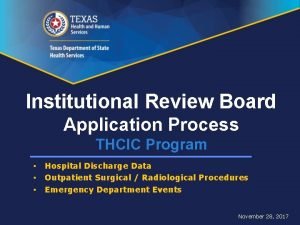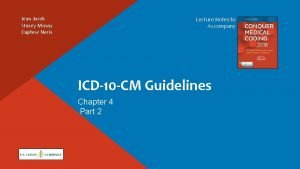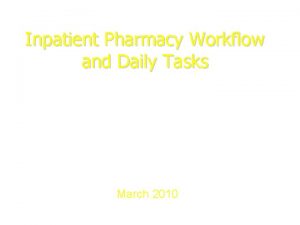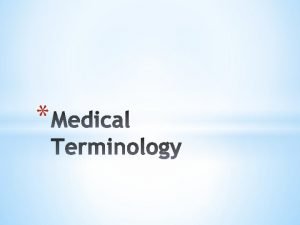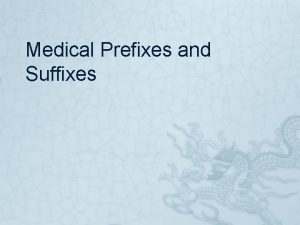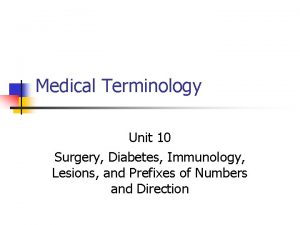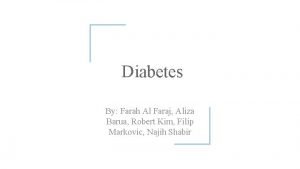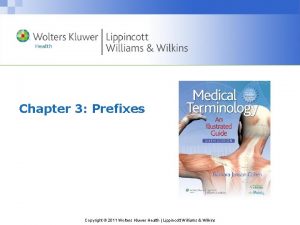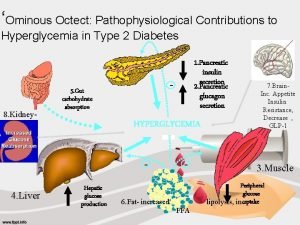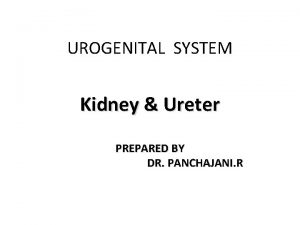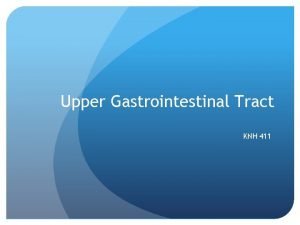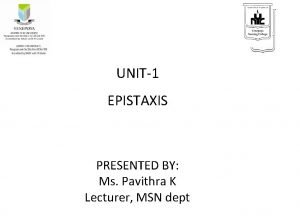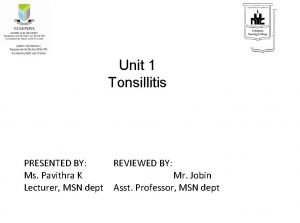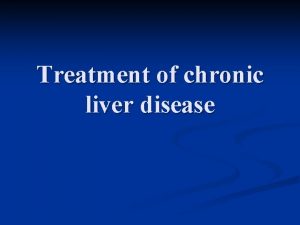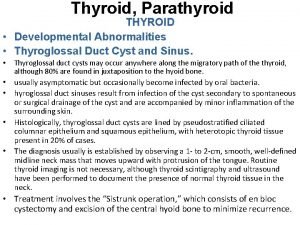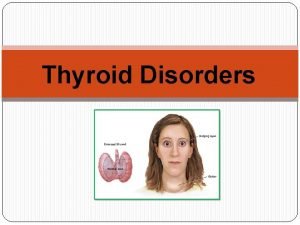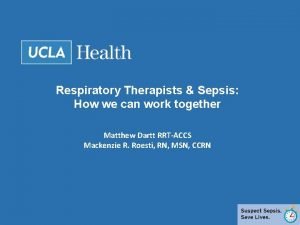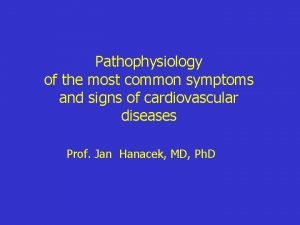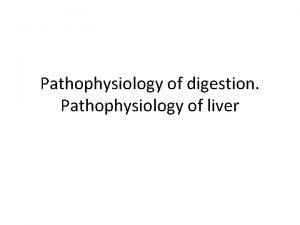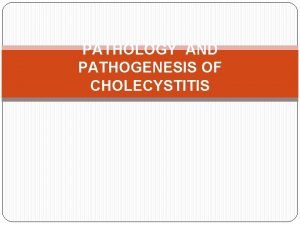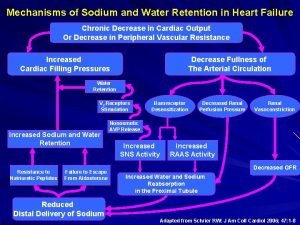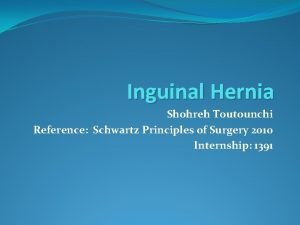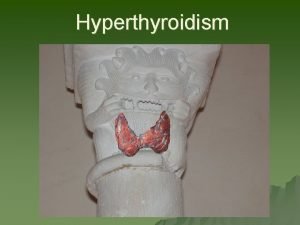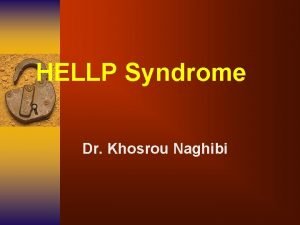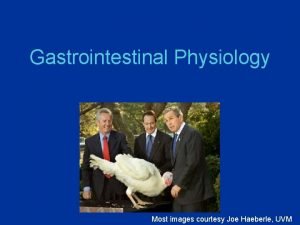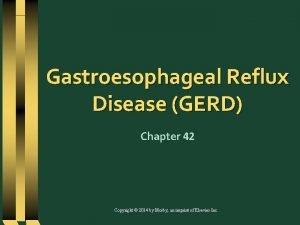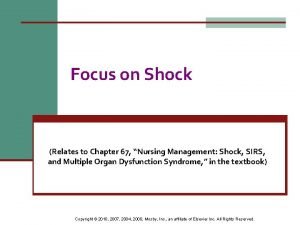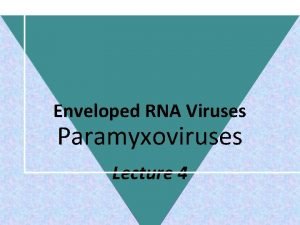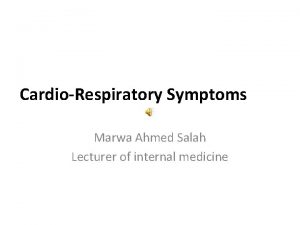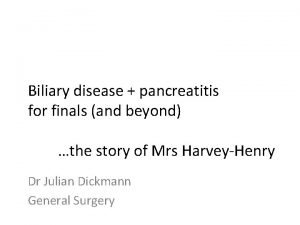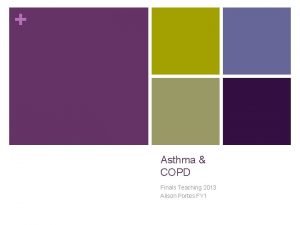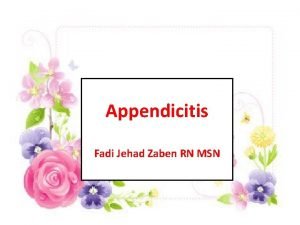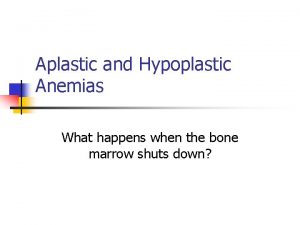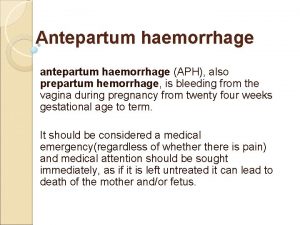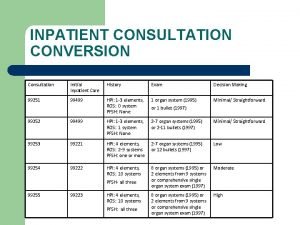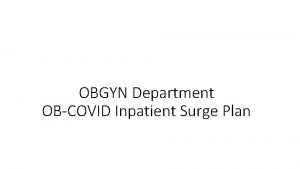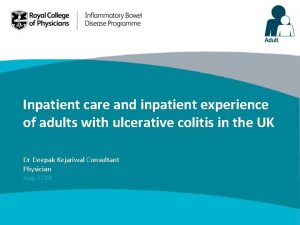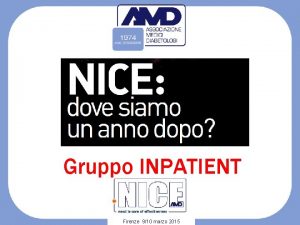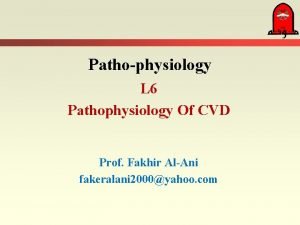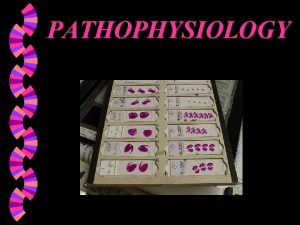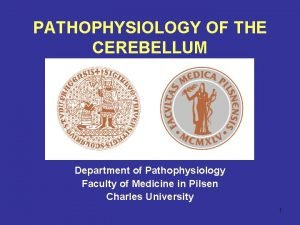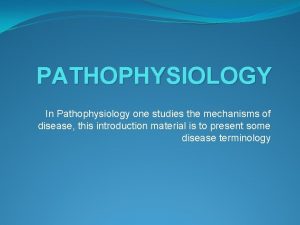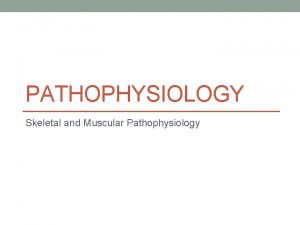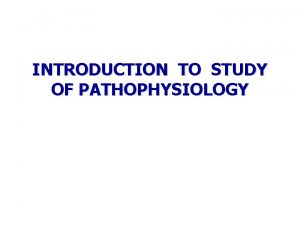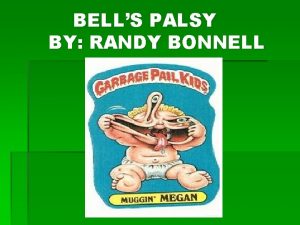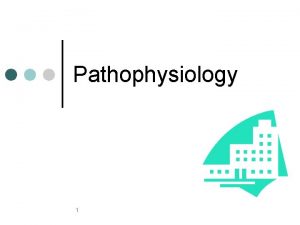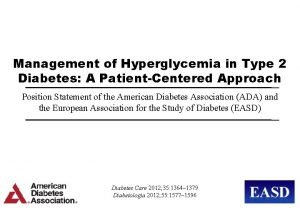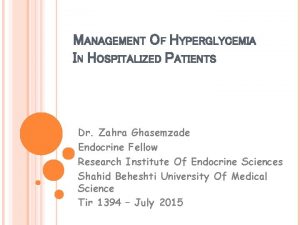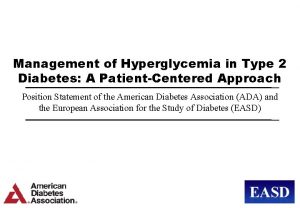Inpatient Hyperglycemia Management EGLCYCLEJun201724 Pathophysiology of Hyperglycemia EGLCYCLEJun201724















































- Slides: 47

Inpatient Hyperglycemia Management EGL/CYCLE/Jun/2017/24

Pathophysiology of Hyperglycemia EGL/CYCLE/Jun/2017/24

Normal Glucose Metabolism: Fed State ¨ Insulin promotes glucose disposal by tissues, primarily muscle, and adipose tissue ¨ Insulin suppresses both glycogenolysis and gluconeogenesis by the liver and lipolysis in adipocytes Aronoff et al. Diabetes Spectrum 2004; 17: 183 -190. EGL/CYCLE/Jun/2017/24

Normal Glucose Metabolism: Fasted State ¨ Insulin promotes glucose disposal by tissues, primarily muscle, and adipose tissue ¨ Plasma glucose is derived from glycogenolysis under the direction of glucagon ¨ Insulin’s role in glycogenolysis and gluconeogenesis suppression is low due to low insulin secretion 1. Aronoff et al. Diabetes Spectrum 2004; 17: 183 -190 2. Williams Textbook of Endocrinology, 12 th Ed. Melmed S, Polonsky K Larsen PR, Kronenberg H. 2011; Saunders. Chap 31 3. Rosen and Speigelman. Nature 006; 444: 847 -853. EGL/CYCLE/Jun/2017/24

Insulin Requirements in Health and Illness ¨ For patients who are sick and eating, there is an increased requirement for basal insulin, a decreased requirement for mealtime insulin and an increased reliance on corrective insulin dosing ¨ For patients who are sick but not eating, basal and nutritional insulin coverage is required to account for TPN, D 5 infusion, or enteral feedings Correction Prandial Nutritional Basal Insulin Units Healthy Sick/Eating Sick/NPO D 5=dextrose 5%; NPO=nothing by mouth; TPN=total parenteral nutrition 1. Clement S et al. Diabetes Care 2004; 27: 553– 91 2. Juneja R et al. Postgrad Med 2010; 122: 153 -62 EGL/CYCLE/Jun/2017/24

Hyperglycemia Upon Admission What is the Hb. A 1 c Value? EGL/CYCLE/Jun/2017/24

Hyperglycemia in Hospitalized Patients Transient (stress) hyperglycemia Previously known diabetes • Opportunity to assess efficacy of preadmission glycemic control • May revert to normal after discharge Possible Etiology Previously unknown/ undiagnosed diabetes • Confirm at discharge and monitor later Juneja R et al. Postgrad Med 2010; 122: 153 -62 EGL/CYCLE/Jun/2017/24

Hyperglycemia Upon Admission Medications to Control the Glucose Level EGL/CYCLE/Jun/2017/24

Anti-hyperglycemic Agents: Targets Neurotransmitter dysfunction Increased hepatic glucose production GLP-1 RA ? Increased glucagon secretion Metformin TZD Decreased incretin effect DPP-4 i SGLT 2 i Hyperglycemia Increased glucose reabsorption GLP-1 RA *Insulins Decreased insulin secretion SU GLP-1 RA TZD DPP-4 i TZD Metformin Decreased glucose uptake Increased lipolysis *Exogenous insulin does not increase insulin secretion but does act as a substitute for decreased endogenous insulin; DPP-4 i=dipeptidyl peptidase 4 inhibitor; GLP-1 RA=glucagon-like peptide-1 receptor agonist; SGLT 2 i=sodium glucose co-transport 2 inhibitor; SU=sulfonylurea; TZD=thiazolidinedione 1. De. Fronzo RA. Diabetes 2009; 58: 773 -95 2. American Diabetes Association. Diabetes Care 2016; 39: S 13 -22 EGL/CYCLE/Jun/2017/24

The Goal of Insulin Treatment Is to Mirror Normal Insulin Secretion Mealtime Insulin Basal Insulin Mealtime Glucose Basal Glucose Data from http: //www. medscape. org/viewarticle/544445 EGL/CYCLE/Jun/2017/24

Use of Basal and Mealtime Insulins will Address Two Sources of Hyperglycemia The relative contribution of basal and prandial hyperglycemia varies between patients and in function of Hb. A 1 c 1 -4 Plasma Glucose (mg/d. L) 250 Mealtime Hyperglycemia Basal Hyperglycemia 200 Type 2 Diabetes 150 100 50 Healthy 0 0600 1200 1800 2400 0600 Time of Day Breakfast 1. 2. Lunch Monnier L et al. Diabetes Care. 2003; 26: 881 -5 Riddle M et al. Diabetes Care 2011; 34: 2508 -14 Dinner 3. 4. Ando K et al. PLo. S One 2013; 8: e 71102 Riddle MC. Diabetes Care 1990; 13: 676 -86 EGL/CYCLE/Jun/2017/24

Hyperglycemia Upon Admission …Target Glucose Values EGL/CYCLE/Jun/2017/24

Glycemic Targets in Hospitalized Patients • Hospital goals for a patient with diabetes include: – Preventing both hyperglycemia and hypoglycemia – Promoting the shortest safe hospital stay – Providing an effective discharge from the hospital in order to prevent acute complications and readmission • • A blood glucose target of 140 -180 mg/d. L is recommended for critically ill patients A blood glucose target of 140 -180 mg/d. L is recommended for patients in noncritical care units • A blood glucose target of 110 -140 mg/d. L is recommended for cardiac surgery patients, patients with acute cardiac ischemia and/or neurological events • A blood glucose target range of 80 -180 mg/d. L is recommended for the perioperative period American Diabetes Association. Diabetes Care 2016; 39(Suppl 1): S 99–S 104; EGL/CYCLE/Jun/2017/24

Types of Insulin Regimens in the Hospital EGL/CYCLE/Jun/2017/24

Means of Insulin Delivery Multiple Daily Injections (MDI) 1 -2 injection per day of basal + 3 -4 injections per day of prandial Insulin Infusion Continuous basal + Mealtime boluses • Both approaches require matching of prandial insulin to carbohydrate intake, premeal blood glucose, and anticipated activity American Diabetes Association. Diabetes Care 2016: 39: S 52 -9 EGL/CYCLE/Jun/2017/24

Classic Basal-Bolus Regimen: Rapid-acting Analog + Long-acting Analog Insulin Effect Endogenous insulin Rapid-acting insulin analog Long-acting insulin analog 60 40 20 0 Breakfast Lunch Skyler JS. In: Therapy for Diabetes Mellitus and Other Related Disorders, Supper EGL/CYCLE/Jun/2017/24

Insulin Action Insulin Infusion Bolus Basal Infusion 6 am 8 am Breakfast 12 pm Lunch 1. Pickup JC. N Engl J Med 2012; 366: 1616 -24 6 pm Dinner 10 pm 3 am Fasting EGL/CYCLE/Jun/2017/24

Starting/Switching to SC Insulin …Rules of the Road EGL/CYCLE/Jun/2017/24

Subcutaneous Therapy Selection Discrete meals No NPH and/or Regular human insulin Yes Basal long-acting analog and Rapid-acting analog insulin NPH=neutral protamine Hagedorn EGL/CYCLE/Jun/2017/24

A Safe and Rapidly Reversible Regimen for a Patient while NPO, on IV’s, or Receiving Continuous Enteral Feedings — NPH Insulin requirement ---R 0600 1200 1800 Time of day 2400 IV=intravenous; NPH=neutral protamine Hagedorn; NPO=nil per os; R=regular human insulin Juneja R et al. Postgrad Med 2010; 122: 153 -62 EGL/CYCLE/Jun/2017/24

Multiple Daily Injections (MDI) Insulin Action Rapid-acting 60 Rapid-acting Basal analog 40 20 0 Breakfast Lunch Meah F and Juneja R. Med Clin North Am. 2015; 99: 157 -86 Supper Time EGL/CYCLE/Jun/2017/24

Sliding Scale Insulin • SSI therapy is generally prescribed with only rapid-acting insulin without any intermediate or long-acting insulins – This is a reactive approach: SSI therapy treats hyperglycemia after it has already occurred, instead of preventing its occurrence – Doses are arbitrarily chosen for a given blood glucose value • As a consequence with SSI insulin: – The insulin dose may be too much resulting in precipitous fall in blood glucose and hypoglycemia – The insulin dose many be too little to correct hyperglycemia SSI=sliding scale insulin 1. Clement S et al. Diabetes Care 2004; 27: 553– 91 2. Juneja R et al. Postgrad Med 2010; 122: 153 -62 EGL/CYCLE/Jun/2017/24

Limitations of Sliding Scale Insulin ¨ Hypothetical situation: a patient with type 1 diabetes is on a standard sliding scale approach during hospitalization in the absence of background or basal insulin ¨ Depending upon the blood glucose level, insulin dose is administered Blood glucose (mg/d. L) 280 6 U 6 U Insufficient insulin 240 To om 200 ns hi uc 0 U 0 U n uli 160 120 0600 1200 1800 Time of day Blood Glucose (mg/d. L) Insulin Units 201– 250 4 251– 300 6 301– 350 8 351– 400 10 2400 EGL/CYCLE/Jun/2017/24

Sliding Scale vs. Scheduled Insulin (Basal Replacement + Meal/Corrective Doses) ¨Hypothetical situation Blood glucose (mg/d. L) 280 6 U 6 U 240 Sliding Scale insulin Long-acting basal insulin 200 160 120 0 U 0 U 0600 1200 Time of day 1800 Blood 2400 Glucose (mg/d. L) ¨Use long-acting basal insulin (0. 2 -0. 3 U/kg) ¨Use corrective scale: 1 U rapid-acting insulin for every 25 mg/d. L blood glucose >100 mg/d. L ¨Add scheduled rapid-acting dose for meals based on carbohydrates consumed IV=intravenous Insulin Units 201– 250 4 251– 300 6 301– 350 8 351– 400 10 EGL/CYCLE/Jun/2017/24

Alternative to Sliding Scale Insulin • SSI therapy is generally prescribed with only rapid-acting insulin without any intermediate or longacting insulins – This is a reactive approach: SSI therapy treats hyperglycemia after it has already occurred, instead of preventing its occurrence – Doses are arbitrarily chosen for a given blood glucose value • • As a consequence with SSI insulin: – The insulin dose may be too much resulting in precipitous fall in blood glucose and hypoglycemia – The insulin dose many be too little to correct hyperglycemia Appropriate way to correct hyperglycemia would be – Administration of long-acting insulin to treat basal hyperglycemia – Additionally • Use corrective Insulin scale: 1 U rapid-acting insulin for every 25 mg/d. L blood glucose >100 mg/d. L • Add scheduled rapid-acting dose for meals based on carbohydrate consumed SSI=sliding scale insulin 1. Clement S et al. Diabetes Care 2004; 27: 553– 91 2. Juneja R et al. Postgrad Med 2010; 122: 153 -62 EGL/CYCLE/Jun/2017/24

Insulin Algorithms …the Right Approach EGL/CYCLE/Jun/2017/24

CASE SCENARIO 1 § § 50 year Male, Wt. - 90 kg K/C/O- T 2 D (On OHA), admitted to ward for sepsis Well oriented, stable, Eating Started on Basal Bolus Insulin (TDD = 0. 6 U/kg Bd. Wt. = 54 U) Day Fasting BL BDN 1 110 320 119 Insulin R 9 R 9 2 250 138 R 9+8 R 9 R= Regular; BL = Before Lunch; BDN= Before Dinner 1. Day 1 to appear first and then Day 2 11 pm 27 32

Discussion Points • Total daily insulin calculation • Correctional insulin • Difference between correctional insulin and sliding scale insulin

Initial Insulin Calculation in Hospitalized Patient With Type 2 Diabetes ¨ Basal insulin 0. 1 -0. 2 units/kg/day ¨ Nutritional insulin 1 unit/10 -15 g carbohydrate ¨ Basal insulin dose calculated on a “per kilogram” basis may decline if over-nutrition ceases or if organ dysfunction occurs American Diabetes Association. Diabetes Care 2016; 39(Suppl. 1): S 52 -9 EGL/CYCLE/Jun/2017/24

Transitioning to Subcutaneous Insulin from Intravenous Insulin • Establish 24 -hour insulin requirement – Extrapolate from average over last 6 -8 hours if stable • Administer 60 -80% amount as basal • Administer p. c. boluses based on carbohydrate intake – Start at 10 -15 g carbohydrate = 1 units rapid-acting • Monitor glucose value a. c. t. i. d. , h. s. , and at 3 AM • Supplement all blood glucose >140 mg/d. L with correction dose of rapid-acting insulin – (Blood glucose - 100)/(1800/daily insulin requirement) a. c. =ante cibum (before meal); h. s. =hora somni (at bedtime); p. c. =post cibum (after meal); t. i. d. =ter in die (three times a day) American Diabetes Association. Diabetes Care 2016; 39(Suppl. 1): S 99–S 104; Meah F, Juneja R. Med Clin North Am. 2015; 99(1): 157 -86 EGL/CYCLE/Jun/2017/24

Types of Insulin …And Why This Matters EGL/CYCLE/Jun/2017/24

Time-action Profiles of Insulin • Time-action profile 1: – Onset: how fast the insulin begins to work – Peak: how soon after the injection it reaches maximum effect – Duration: how long the insulin action lasts • Normal physiologic insulin secretion includes both 2: – Continuous basal (low-level) secretion – Incremental secretion following meals • Insulin formulations were developed to alter time-action profiles in an attempt to make insulin replacement mimic, as much as possible, the body’s own insulin releasing pattern 3 1. 2. 3. 4. http: //www. diabetes. org/living-with-diabetes/treatment-and-care/medication/insulin-basics. html Unger J. Prim Care 2007; 34(4): 791 -808, vi-vii Hartman I. Clin Med Res 2008; 6(2): 54 -6 Meah F and Juneja R. Med Clin North Am 2015; 99(1): 157 -86 EGL/CYCLE/Jun/2017/24

Time-action Profile of Rapid-acting Insulin: Eglucent® Serum Insulin Levels (ng/m. L) Insulin lispro: serum insulin levels (ng/m. L) after subcutaneous injection in healthy volunteers (n=10) 5 Insulin lispro (ie, Humalog®) Insulin human recombinant (eg, Humulin® R) 4 3 2 1 0 0 1 2 3 4 5 6 7 8 9 10 11 12 Time (Hours) Superior PPG control, Less Hypoglycemia Muzaffer Z et al. J Pak Med Assoc 1998; 48(7): 212 -4 EGL/CYCLE/Jun/2017/24

Time-action Profiles of Exogenously Administered Insulin 1 Insulin lispro, aspart, glulisine 1. 0 Rapid Acting Analog insulins: Eglucent®, Novo. Log®, Apidra® Plasma insulin levels Regular insulin Humulin® R, Novolin® R NPHa Humulin® N, Novolin® N Insulin detemir Long acting analog insulin: Levemir® Insulin glargine 0. 5 Long acting analog insulin: Lantus®, Basaglar® Insulin glargine U-3002, degludec Long acting analog insulin: Toujeo®, Tresiba® 0. 0 0 a. Needs 1. 2. to be mixed before injection Data from Mc. Mahon GT et al. N Engl J Med 2007; 357: 1759 -1761 Toujeo® [Package Insert], Sanofi; 2015 12 Time (Hours) 24 EGL/CYCLE/Jun/2017/24

Special Situations Nil Per Os (NPO) EGL/CYCLE/Jun/2017/24

CASE SCENARIO 2 § 70 year old with CVA. ↓ GCS § Glimipiride 3 mg and Metformin 1000 mg § CBG = 280 § Rapid insulin 12/10/10 Day 6 am 12 noon 6 pm 12 mn 1 60 320 119 180 2 56 280 230 GCS= Glassgow Coma Scale

Discussion Points • Approach to patient’s insulin therapy who is nil per mouth • Approach to patient’s insulin therapy who is on enteral/parenteral feeds

Suggested Regimens NPH (~ 67 %) Glargine (not more than 50 %) R (at least 50 %) R (~ 33 %) Insulin requirement ¨ Regimens for patient while NPO, on IV, or receiving continuous enteral feedings Insulin requirement Time of day NPH=neutral protamine Hagedorn; NPO=nil per os; R=regular human insulin; TPN=total parenteral nutrition 1. Clement S et al. Diabetes Care 2004; 27: 553– 91 2. Juneja R et al. Postgrad Med 2010 Jan; 122: 153 -62 NPH Time of day EGL/CYCLE/Jun/2017/24

A Safe and Rapidly Reversible Regimen for a Patient while NPO, on IVs, or Receiving Continuous Enteral Feedings — NPH Insulin requirement ---R 0600 1200 1800 Time of day IV=intravenous; NPH=neutral protamine Hagedorn; NPO=nil per os; R=regular human insulin 1. Clement S et al. Diabetes Care 2004; 27: 553– 91 2. Juneja R et al. Postgrad Med 2010; 122: 153 -62 2400 EGL/CYCLE/Jun/2017/24

Special Situations Enteral Feeding and Grazing EGL/CYCLE/Jun/2017/24

CASE SCENARIO 3 • A 58 -year-old woman, with type 2 diabetes, on glibenclamide and metformin, is scheduled for an elective open laparotomy for GI pathology • What do you do with this patient’s glycemic control? A. Stop OHA on the day of surgery. Start i/v insulin with glucose and potassium in the same bag (the GIK regimen). Restart OHA +/s/c insulin post op once pt start resumes meals B. Stop OHA on the day of surgery. Start separate i/v insulin and i/v glucose. Restart OHA +/- s/c insulin post op once pt start resumes meals

Discussion Points • Pre Op & Post Operative Recommendations • Post Surgery when to resume oral feeds • Choice of bolus insulin in these scenarios- when iv & when s/c – Regular Vs Rapid acting analog insulin in such scenarios

Suggested regimen Insulin requirement Theoretical insulin requirement Insulin requirement Overnight enteral feedings/ daytime grazing R NPH Time of day NPH=neutral protamine Hagedorn; R=regular human insulin 1. Clement S et al. Diabetes Care 2004; 27: 553– 91 2. Juneja R et al. Postgrad Med 2010; 122: 153 -62 EGL/CYCLE/Jun/2017/24

Special Situations Pre-operative Patient EGL/CYCLE/Jun/2017/24

Procedures, Anesthesia and Surgery: Suggested Regimens Glargine Doses Today’s Yesterday’s with Procedures, brief NPO status, or anesthesia <1 hour Lispro /aspart Glargine Insulin requirement Established basal therapy peakless long-acting insulin analog Insulin requirement Prolonged NPO status or anesthesia >1 hour Yesterday’s Glargine Dose Insulin Drip NPO=nil per os Juneja R et al. Postgrad Med 2010 Jan; 122: 153 -62 EGL/CYCLE/Jun/2017/24

Summary ¨ In the hospital, multiple factors influence a patient’s insulin requirements • Insulin requirements are typically increased from the healthy state ¨ Patients who manifest hyperglycemia at the time of admission could have • Previously diagnosed diabetes • Diagnosed for the first time during hospitalization • Manifest “stress hyperglycemia” during an acute illness that resolves by the time of discharge ¨ The goal of insulin therapy is to better control postprandial glycemic excursions using a fast-acting insulin and then decreased hepatic glucose production between meals and at night with a basal insulin ¨ A blood glucose target of 140 -180 mg/d. L (7. 8 -10. 0 mmol/L) is appropriate for most in-patient settings Juneja R et al. Postgrad Med 2010; 122: 153 -62 ; Bretzel RG et al. Diabetes Care 2009; 32 Suppl 2: S 260 -5; American Diabetes. EGL/CYCLE/Jun/2017/24 Association. Diabetes

Thank you EGL/CYCLE/Jun/2017/24
 Management of hyperglycemia
Management of hyperglycemia Management of hyperglycemia
Management of hyperglycemia Miracles wichita kansas
Miracles wichita kansas Inpatient in nh
Inpatient in nh Dshs irb
Dshs irb Poa indicators are assigned in the inpatient setting for
Poa indicators are assigned in the inpatient setting for Inpatient pharmacy workflow
Inpatient pharmacy workflow Beta agonist hyperglycemia
Beta agonist hyperglycemia Amniocentesis root word
Amniocentesis root word Hyperglycemia prefix and suffix
Hyperglycemia prefix and suffix Pyr medical definition
Pyr medical definition Asymptomatic hyperglycemia
Asymptomatic hyperglycemia Signs and symptoms of hyperglycemia
Signs and symptoms of hyperglycemia Leuk prefix
Leuk prefix Glp
Glp Perinephric abscess symptoms
Perinephric abscess symptoms Dumping syndrome pathophysiology
Dumping syndrome pathophysiology Petroleum gauze
Petroleum gauze Tonsillitis pathophysiology
Tonsillitis pathophysiology Hepatic encephalopathy pathophysiology
Hepatic encephalopathy pathophysiology Thyroglossal cyst pathophysiology
Thyroglossal cyst pathophysiology Hyperthyroidism hypokalemia
Hyperthyroidism hypokalemia Neonatal sepsis pathophysiology diagram
Neonatal sepsis pathophysiology diagram Paroxysmal nocturnal dyspnea pathophysiology
Paroxysmal nocturnal dyspnea pathophysiology Pathophysiology of jaundice
Pathophysiology of jaundice Acute calculous cholecystitis
Acute calculous cholecystitis Nursing management of thyrotoxicosis
Nursing management of thyrotoxicosis Pathophysiology of sodium and water retention
Pathophysiology of sodium and water retention Inguinal hernia taxis maneuver
Inguinal hernia taxis maneuver Toxic multinodular goiter
Toxic multinodular goiter Iodine defintion
Iodine defintion Pathophysiology of hirschsprung disease
Pathophysiology of hirschsprung disease Hellp syndrome pathophysiology
Hellp syndrome pathophysiology Dumping syndrome pathophysiology
Dumping syndrome pathophysiology Why “avoid chocolate” after nissen fundoplication
Why “avoid chocolate” after nissen fundoplication Anaphylactic shock pathophysiology flowchart
Anaphylactic shock pathophysiology flowchart Pathophysiology of measles
Pathophysiology of measles Disseminated intravascular coagulation pathophysiology
Disseminated intravascular coagulation pathophysiology Paroxysmal nocturnal dyspnea pathophysiology
Paroxysmal nocturnal dyspnea pathophysiology Cholecystitis pathophysiology
Cholecystitis pathophysiology Pathophysiology definition
Pathophysiology definition Status asthmaticus pathophysiology
Status asthmaticus pathophysiology Asthma pathophysiology
Asthma pathophysiology What is the pathophysiology of appendicitis?
What is the pathophysiology of appendicitis? Pathophysiology of appendicitis
Pathophysiology of appendicitis Aplastic anemia lab findings
Aplastic anemia lab findings Prepartum haemorrhage
Prepartum haemorrhage Acute glomerulonephritis pathophysiology
Acute glomerulonephritis pathophysiology
